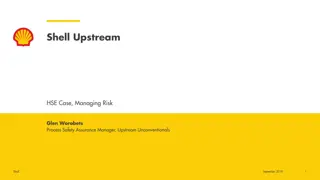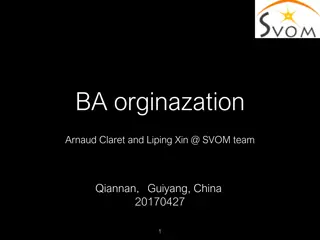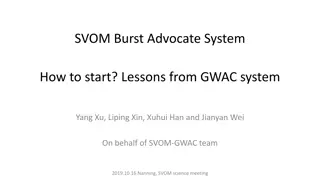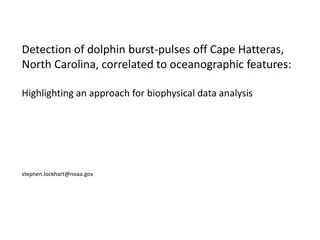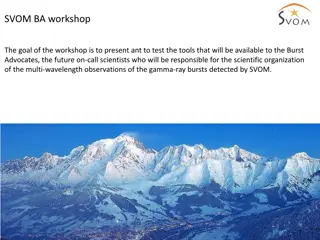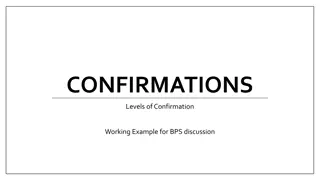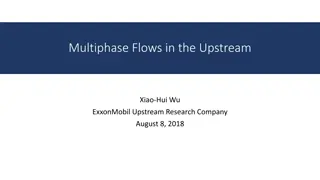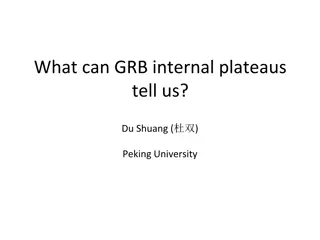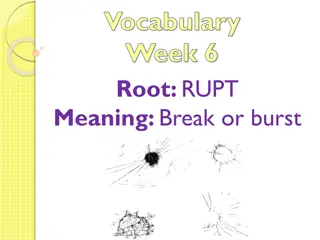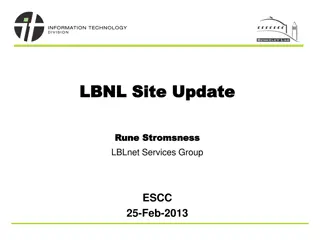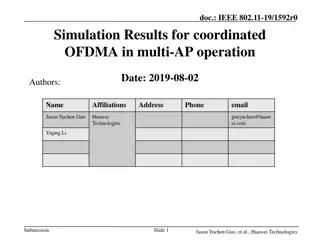Evolution of Upstream Burst Structure in 100G EPON Networks
Explore the advancements in upstream burst structure for 100G EPON networks discussed in IEEE 802.3 Working Group meetings. Key topics covered include burst loss probabilities, synchronization issues, SoB requirements, and the importance of burst delimiters. Updated analyses using MATLAB scripts and considerations for line code selection are highlighted, emphasizing the need for effective synchronization patterns and fault-tolerant burst structures to enhance network performance.
Download Presentation

Please find below an Image/Link to download the presentation.
The content on the website is provided AS IS for your information and personal use only. It may not be sold, licensed, or shared on other websites without obtaining consent from the author. Download presentation by click this link. If you encounter any issues during the download, it is possible that the publisher has removed the file from their server.
E N D
Presentation Transcript
Upstream Burst Structure Marek Hajduczenia, Charter January 2018 IEEE 802.3 Working Group meeting, Geneva, Switzerland R07
100GEPON Highlights Overview materials sourced from 10G-EPON project: 3av_0701_effenberger_1.pdf. Burst structure, locking mechanism, and general analysis methodology is equally applicable to 100G-EPON as well Burst loss and false lock probabilities were updated and are now cumulative rather than approximate. Calculations carries out using Matlab script (attached) for delimiters lengths of 66, 132, 129, and 257 bits, aligned with different line code options. 66-bit long delimiter insufficient for NG-EPON with raw BER of 10-2and higher burst rates (0.011 years long burst loss) Little difference between 132- and 129-bit long delimiters, both could be adopted for NG-EPON Alignment with selected line code will decide between 129, 132, and 257-bit (or any other) long delimiters 2 January 2018 IEEE 802.3 Working Group meeting, Geneva, Switzerland
100GEPON Upstream Synchronization Issues OLT adjusts gain and recovers clock (AGC/CDR) during special burst portion (0xBF4018E5C549BB59, SP per 76.3.2.5.2) called Sync Pattern / Time OLT cannot use FEC until FEC codeword boundary is reliably detected using pre-FEC (uncorrected) data OLT must be able to reliably locate X-bit block boundary to identify start of FEC-encoded data (X could be 66, 132, 129, 257, depending on line code selection) Laser On Time Threshold adjustment Clock adjustment Lock on 66-bit block and FEC codeword boundary Sync Time FEC codeword FEC codeword 3 January 2018 IEEE 802.3 Working Group meeting, Geneva, Switzerland
100GEPON Upstream Burst Structure Similar to 10G-EPON, Sync Time pattern needs to be followed by well-known Start of Burst (SoB) delimiter High frequency pattern for fast AGC and CDR Burst Delimiter Last FEC codeword *may* be truncated 0x5555... FEC codeword FEC codeword SoB pattern must have high Hamming distance with any false synchronization candidate position Burst Delimiter 0x5555... Burst Delimiter Large Hamming Distance Large Hamming Distance Burst Delimiter Small Hamming Distance (or 0) Burst Delimiter 4 January 2018 IEEE 802.3 Working Group meeting, Geneva, Switzerland
100GEPON SoB Requirements There are several SoB requirements Large Hamming distance with Sync Pattern in the upstream burst (0xBF4018E5C549BB59, SP per 76.3.2.5.2) Large Hamming distance with its own shifted version Large Hamming distance against both patterns even in presence of E bit errors within the sequence (pre-FEC) Close to DC balance (same number of 1s and 0s) Example of 66-bit SoB and its Hamming distance 66b value: 000101010010101110111110011101101001111000001111011100001001000110 Hamming Distance 50 40 30 20 10 0 -70 -60 -50 -40 -30 -20 -10 0 Offset (bits) 5 January 2018 IEEE 802.3 Working Group meeting, Geneva, Switzerland
100GEPON Locking Probabilities /1 Assume: N = block size in bits (66), E1 = admissible bit error count per block (e.g., 12), E2 = number of bit errors in sync pattern to turn it into a barely matching pattern, resulting in false detection (e.g., 20), and BER = bit error ratio for incoming data stream (e.g., 10-3). E2 = HD E1 + 1, where HD = Hamming Distance of SoB delimiter When a burst arrives, OLT correlator searches for the SoB, tolerating up to E1-1 errors Probability of missing burst lock (burst loss, Ploss): at least E1 bit errors in delimiter of N bits and OLT correlator will not find the delimiter sequence properly in incoming data stream with raw bit error ratio of BER ? ?! ?! ? ? ! ???? ? ???? ? ?=?? 6 January 2018 IEEE 802.3 Working Group meeting, Geneva, Switzerland
100GEPON Locking Probabilities /2 Probability of false burst lock (Pfalse): for any position within Sync Time, if two N-bit blocks have a Hamming distance of HD, then any random error has HD/N chance of reducing HD and (N-HD)/N chance of increasing it. The false lock only happens when the number of errors that reduce HD exceed the number of errors that increase HD by E2. False lock can happen for any shift position (S) within the Sync Time on any of the active data lanes (L). Number of shift positions within Sync Time depends on Sync Time size (in ns, Sb), line code selected (in bits, code block pre coding, e.g., 64, Npre, and code block post coding, e.g., 66, Npost), MAC rate (in Gbps, RMAC), and SoB size (in bits, N) ? ?? ???? ????? ? ?? ? ???? ??! ?! ?? ? ! ???? ? ????? ? ? ???? ?? ?=?? ?=?? 7 January 2018 IEEE 802.3 Working Group meeting, Geneva, Switzerland
100GEPON Locking Probabilities /3 Mean Time To (MTT) burst loss (SoB is not detected correctly) and false burst lock (SoB was detected at the wrong position due to bit errors in sync pattern) is related to the average burst rate and burst size. For calculation, assume 1 Mburst/sec (across 4 lanes) = 4 s-long burst per lane (4 lane active, worst case scenario) Sync Time (Sb) length is derived from existing 10G-EPON values; use Figure 76 14 for general view of burst structure, 75.7.14 for Ton/Toff measurement procedure and values of individual parameters; Figure 60 8 shows details of burst structure timing All max values: Ton = 512 ns, Treceiver_settling = 800 ns, Tcdr = 400 ns, Tcode_group_align = 0 ns, Toff = 512 ns Sb = Ton + Treceiver_settling + Tcdr + Tcode_group_align = = 512 + 800 + 400 ns = 1712 ns (max) 8 January 2018 IEEE 802.3 Working Group meeting, Geneva, Switzerland
100GEPON Results - 64b/66b line code MTT burst loss / burst false in function of E1 error count, for different BER rates, for 64b/66b line code 180 10 Age of Universe MTT Burst Loss for BER = 10-2 MTT Burst False for BER = 10-2 MTT Burst Loss for BER = 10-3 MTT Burst False for BER = 10-3 MTT Burst Loss for BER = 10-4 MTT Burst False for BER = 10-4 MTT Burst Loss for BER = 10-5 MTT Burst False for BER = 10-5 MTT Burst Loss for BER = 10-6 MTT Burst False for BER = 10-6 With HD of 32, for 64b/66b line code with for BER = 10-2 we cannot simultaneously guarantee Age of Universe (AoU, or better) values for MTT burst loss / false lock values. Both MTT curves intersect below reference AoU line. 160 10 140 10 120 10 With HD of 32, for 64b/66b line code with for BER = 10-3 we can guarantee AoU with up to 17 bit error tolerance (optimum detection threshold) 100 10 MTT [year] 80 10 60 10 40 10 20 10 Age of Universe (AoU) 0 10 -20 10 1 3 5 7 9 11 13 15 E1 error count [bit] 17 19 21 23 25 27 29 31 number of admissible bit errors (E1) in SoB 9 January 2018 IEEE 802.3 Working Group meeting, Geneva, Switzerland
100GEPON Results - 128b/129b line code MTT burst loss / burst false in function of E1 error count, for different BER rates, for 128b/129b line code 300 10 Age of Universe MTT Burst Loss for BER = 10-2 MTT Burst False for BER = 10-2 MTT Burst Loss for BER = 10-3 MTT Burst False for BER = 10-3 MTT Burst Loss for BER = 10-4 MTT Burst False for BER = 10-4 MTT Burst Loss for BER = 10-5 MTT Burst False for BER = 10-5 MTT Burst Loss for BER = 10-6 MTT Burst False for BER = 10-6 With HD of 63, for 128b/129b line code, with BER = 10-2 we can tolerate between 24 and 42 bit errors (E1), without dropping below Age of Universe for MTT burst loss / false lock values. 250 10 200 10 E1 ~= 33 maximizes both MTT values simultaneously (optimum detection threshold) 150 10 MTT [year] 100 10 50 10 Age of Universe (AoU) 0 10 -50 10 1 3 5 7 9 11 13 15 17 19 21 23 25 27 29 31 33 35 37 39 41 43 45 47 49 51 53 55 57 59 61 62 E1 error count [bit] number of admissible bit errors (E1) in SoB 10 January 2018 IEEE 802.3 Working Group meeting, Geneva, Switzerland
100GEPON Results - 128b/132b line code MTT burst loss / burst false in function of E1 error count, for different BER rates, for 128b/132b line code 300 10 Age of Universe MTT Burst Loss for BER = 10-2 MTT Burst False for BER = 10-2 MTT Burst Loss for BER = 10-3 MTT Burst False for BER = 10-3 MTT Burst Loss for BER = 10-4 MTT Burst False for BER = 10-4 MTT Burst Loss for BER = 10-5 MTT Burst False for BER = 10-5 MTT Burst Loss for BER = 10-6 MTT Burst False for BER = 10-6 With HD of 63, for 128b/132b line code, with BER = 10-2 we can tolerate between 25 and 41 bit errors (E1), without dropping below Age of Universe for MTT burst loss / false lock values. 250 10 200 10 E1 ~= 33 maximizes both MTT values simultaneously (optimum detection threshold) 150 10 MTT [year] 100 10 50 10 Age of Universe (AoU) 0 10 -50 10 1 3 5 7 9 11 13 15 17 19 21 23 25 27 29 31 33 35 37 39 41 43 45 47 49 51 53 55 57 59 61 62 E1 error count [bit] number of admissible bit errors (E1) in SoB 11 January 2018 IEEE 802.3 Working Group meeting, Geneva, Switzerland
100GEPON Results - 256b/257b line code /a MTT burst loss / burst false in function of E1 error count, for different BER rates, for 256b/257b line code 300 10 Age of Universe MTT Burst Loss for BER = 10-2 MTT Burst False for BER = 10-2 MTT Burst Loss for BER = 10-3 MTT Burst False for BER = 10-3 MTT Burst Loss for BER = 10-4 MTT Burst False for BER = 10-4 MTT Burst Loss for BER = 10-5 MTT Burst False for BER = 10-5 MTT Burst Loss for BER = 10-6 MTT Burst False for BER = 10-6 With HD of 128, for 256b/257b line code, with BER = 10-2 we can tolerate between 31 and 101 bit errors (E1), without dropping below Age of Universe for MTT burst loss / false lock values. 250 10 200 10 E1 ~= 69 maximizes both MTT values simultaneously (optimum detection threshold) 150 10 MTT [year] 100 10 50 10 Age of Universe (AoU) 0 10 -50 10 1 3 5 7 9 11 13 15 17 19 21 23 25 27 29 31 33 35 37 39 41 43 45 47 49 51 53 55 57 59 61 63 65 67 69 71 73 75 77 79 81 83 85 87 89 91 93 95 97 99 101 103 105107 109 111113 115117 119 121123 125 127 E1 error count [bit] number of admissible bit errors (E1) in SoB 12 January 2018 IEEE 802.3 Working Group meeting, Geneva, Switzerland
100GEPON Results - 256b/257b line code /b MTT burst loss / burst false in function of E1 error count, for different BER rates, for 256b/257b line code 300 10 Age of Universe MTT Burst Loss for BER = 10-2 MTT Burst False for BER = 10-2 MTT Burst Loss for BER = 10-3 MTT Burst False for BER = 10-3 MTT Burst Loss for BER = 10-4 MTT Burst False for BER = 10-4 MTT Burst Loss for BER = 10-5 MTT Burst False for BER = 10-5 MTT Burst Loss for BER = 10-6 MTT Burst False for BER = 10-6 With HD of 120, for 256b/257b line code, with BER = 10-2 we can tolerate between 31 and 94 bit errors (E1), without dropping below Age of Universe for MTT burst loss / false lock values. 250 10 200 10 E1 ~= 65 maximizes both MTT values simultaneously (optimum detection threshold) 150 10 MTT [year] 100 10 50 10 Age of Universe (AoU) 0 10 -50 10 1 3 5 7 9 11 13 15 17 19 21 23 25 27 29 31 33 35 37 39 41 43 45 47 49 51 53 55 57 59 61 63 E1 error count [bit] 65 67 69 71 73 75 77 79 81 83 85 87 89 91 93 95 97 99 101 103 105 107 109 111 113 115 117 119 number of admissible bit errors (E1) in SoB 13 January 2018 IEEE 802.3 Working Group meeting, Geneva, Switzerland
100GEPON Results - 256b/257b line code /c MTT burst loss / burst false in function of E1 error count, for different BER rates, for 256b/257b line code 300 10 Age of Universe MTT Burst Loss for BER = 10-2 MTT Burst False for BER = 10-2 MTT Burst Loss for BER = 10-3 MTT Burst False for BER = 10-3 MTT Burst Loss for BER = 10-4 MTT Burst False for BER = 10-4 MTT Burst Loss for BER = 10-5 MTT Burst False for BER = 10-5 MTT Burst Loss for BER = 10-6 MTT Burst False for BER = 10-6 With HD of 110, for 256b/257b line code, with BER = 10-2 we can tolerate between 31 and 85 bit errors (E1), without dropping below Age of Universe for MTT burst loss / false lock values. 250 10 200 10 E1 ~= 60 maximizes both MTT values simultaneously (optimum detection threshold) 150 10 MTT [year] 100 10 50 10 Age of Universe (AoU) 0 10 -50 10 1 3 5 7 9 11 13 15 17 19 21 23 25 27 29 31 33 35 37 39 41 43 45 47 49 51 53 55 57 59 61 63 65 67 69 71 73 75 77 79 81 83 85 87 89 91 93 95 97 99 101 103 105 107 109 E1 error count [bit] number of admissible bit errors (E1) in SoB 14 January 2018 IEEE 802.3 Working Group meeting, Geneva, Switzerland
100GEPON Calculation Scripts /Matlab Matlab .m file implementation of cumulative Ploss and Pfalse calculations is attached (above) Calculation parameters are described in the files: varMacRate = MAC data rate, in Gbps varLaneCount = number of active lanes varBurstCountPerSecond = burst number per second varBlockSizeCoded = line code block, post coding, e.g., 66 bits varBlockSizePreCoded = line code block, pre coding, e.g., 64 bits varHammingDistance = target Hamming distance For calculations, a year is assumed to be 31,556,952 seconds long (solar year, not an average calendar year) Script plots MTT burst loss / false burst lock for BER of 10-2, 10-3, 10-4, 10-5, and 10-6 15 January 2018 IEEE 802.3 Working Group meeting, Geneva, Switzerland
100GEPON Delimiter Search /1 Based on C++ optimized Gosper algorithm (also known as SNOOB = Same Number Of One Bits) Mechanism relies on bitwise operations to find the next smallest (N+1) number following current number (N, where both numbers have the same number of 1s/0s in binary form. Calculations start from the smallest number meeting DC balance criteria, e.g., 66-bit number, with 32 x 1s and 32 x 0s, where all 1s are rightmost, i.e., 0x1FFFFFFFF. Iterate through the search space, calculating N+1 delimiter meeting DC balance criteria based on N delimiter. Process is iterative and there is no known algorithm to calculate N+M (where M > 1) delimiter value based on N delimiter value Once given DC balance space is exhausted, search through DC-unbalanced delimiters, e.g., 31 x 1s + 33 x 0s and inverse. Solution space depends on the size of acceptable DC balance for the target sequence. Search methodology does not change, though, irrespective of the starting DC balance condition. 16 January 2018 IEEE 802.3 Working Group meeting, Geneva, Switzerland
100GEPON Delimiter Search /2 Based on C++ optimized Gosper algorithm (also known as SNOOB = Same Number Of One Bits) C++-optimizations possible only via aggregation of intermediate N+1 delimiters and calculation of search criteria values (run-length, Hamming distance) across multiple threads. For better compute efficiency, parallel calculations are offloaded to CUDA GPU due to large number of threads blocks (e.g., o GTX1080, 2560 x 1024 parallel calculations). Implemented fast 512-bit long unsigned integer class to support delimiter searches past 64-bit long sequences, limited by native C++ long long unsigned int type. Existing large integer classes are flexible but suffer from low performance. C++11 compatible Visual Studio 2017 multi-threaded implementation with GPU (CUDA) offload is attached below. 17 January 2018 IEEE 802.3 Working Group meeting, Geneva, Switzerland
100GEPON Delimiter Search /3 Output for 44-bit long delimiters (test run) 44-bit long delimiter, 21/23 DC balance, run length up to 10 bits, minimum Hamming distance of 21 or better 44-bit long delimiter, 22/22 DC balance, run length up to 10 bits, minimum Hamming distance of 21 or better 44-bit long delimiter, 23/21 DC balance, run length up to 10 bits, minimum Hamming distance of 21 or better Target sequence can be then selected based on DC balance and expected run length, e.g., 22/22 balance, 3 or shorter run length 18 January 2018 IEEE 802.3 Working Group meeting, Geneva, Switzerland






